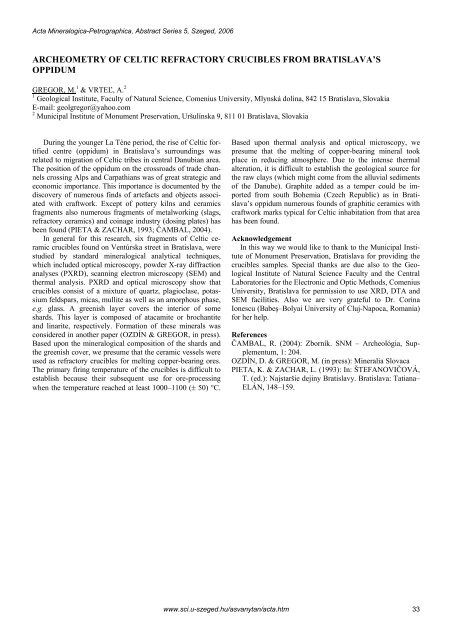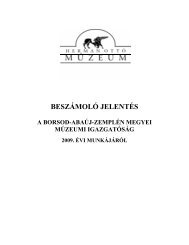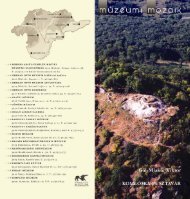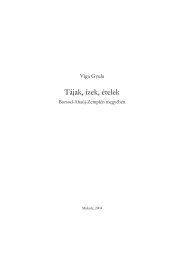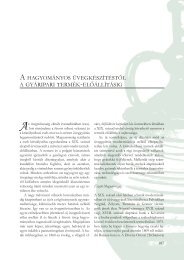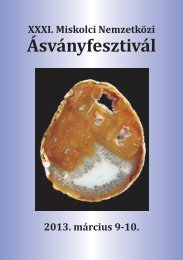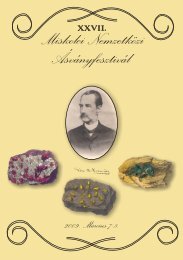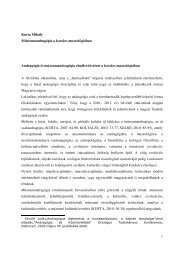Acta Mineralogica-Petrographica, Abstract Series 5, Szeged, 2006<strong>THE</strong> <strong>IN</strong>FLUENCE OF VADU CRIŞULUI KAOL<strong>IN</strong> ON TECHNOLOGICALCHARACTERISTICS AND MICROSTRUCTURE OF SILICA PORCELA<strong>IN</strong>GOREA, M. 1 , KRISTÁLY, F. 2 & ZAJZON, N. 21 Department of Chemical Engineering and Oxide Material Science, Babeş-Bolyai University, Arany János Str. no. 11,RO-400028 Cluj-Napoca, RomaniaE-mail: mgorea@chem.ubbcluj.ro2 Department of Mineralogy and Petrology, University of Miskolc, H-3515 Mikolc-Egyetemváros, HungaryPorcelain has been used as an electrical insulating materialsince a long time due to its specific properties (mechanicalstrength, high-power dielectric strength, and corrosionresistance). Two types of porcelain insulators are mostlyused, the silica and alumina porcelain (classified as C-110and C-120 sub-groups, respectively, according to the IEC672-3 standard). In the silica porcelain body the solid quartzcontent is higher than in that of the alumina porcelain and,correspondingly, its mechanical strength is greater. The differencebetween thermal expansion of the quartz grains andthe surrounding liquid phase causes mechanical stress thatcan produce, during thermal treatment, microcracks in theporcelain.The main raw materials used for obtaining traditionalporcelains are kaolins (about 50%), feldspar (25%) andquartz (25%). The clay acts as a binder for the other constituentsin the raw materials mixture, and it confers plasticity tothe body for shaping. Feldspar is a flux material that reactswith the other compounds, forms a liquid phase in the systemand leads to densification of the body microstructure. Quartzis a refractory material, stable filler that reduces distortionand shrinkage of the ceramics during the thermal treatment.The final microstructure of the fired porcelain consists ofcoarse aggregate particles held together by a finer matrix orbond system that is dense.The goal of this paper is to study the influence of VaduCrişului kaolin, used as a replacement for other clay materials,on the technological characteristics and microstructure ofsilica electrical porcelain. The experiments are focused ontwo aspects: characterization of Vadu Crişului kaolin andsynthesis and characterization of three compositions of porcelain.The chemical composition of Vadu Crişului kaolin is presentedin Table 1.Results of the semi-quantitative mineralogical analysis:quartz – 11%; kaolinite – 78%; illite/micas – 9%; iron oxidesand hidroxides – 2%.The main technological characteristics are: Pffeferkornplasticity index – 41.10%; bending strength – 24 daN/cm 2 ;total shrinkage – 19%; whiteness – 45%.The experimental compositions also include other clayraw materials: Bojidar, KDH and Zettlitz kaolin, as well asthe nonplastic materials, AC-type feldspar and Miorcaniquartz-rich sand. The first composition contains 43% clayeymaterials (no Vadu Crişului kaolin), with a feldspar/sand(F/S) ratio 1.28; the second composition includes 47.5%clayey materials (21% Vadu Crişului kaolin) with a F/S ratioof 1.28; the third composition consists of 46.5% clayey materials(10.75% Vadu Crişului kaolin) with a F/S ratio of 1.37.The main technological characteristics of the ceramic masseshave similar values.The microstructure of the porcelain bodies obtained fromthe three compositions was further investigated by EDSanalyses combined with SEM observations. EDS analyseswere carried out on the vitreous matrix of the bodies, delimitedby the use of BSE images, in order to establish the Si/Alratio and content of Na and K of the matrix, which is determinedby the initial clay component and feldspar dispersionin the volume of ceramic body before firing. The porosity ofporcelain strongly depends on the variation of Si/Al ratio andalkali content of the vitreous matrix. Thus, porosity deducedfrom SEM images, correlated with the composition of thematrix shows the influence of clay components on the microstructureof porcelain body.Table 1: Chemical composition of Vadu Crişului kaolin.SiO 2 Al 2 O 3 Fe 2 O 3 CaO MgO Na 2 O K 2 O L.O.I.52.99 31.35 1.43 0.66 0.53 0.09 1.09 11.4632www.sci.u-szeged.hu/asvanytan/acta.htm
Acta Mineralogica-Petrographica, Abstract Series 5, Szeged, 2006ARCHEOMETRY OF CELTIC REFRACTORY CRUCIBLES FROM BRATISLAVA’SOPPIDUMGREGOR, M. 1 & VRTEĽ, A. 21 Geological Institute, Faculty of Natural Science, Comenius University, Mlynská dolina, 842 15 Bratislava, SlovakiaE-mail: geolgregor@yahoo.com2 Municipal Institute of Monument Preservation, Uršulínska 9, 811 01 Bratislava, SlovakiaDuring the younger La Tène period, the rise of Celtic fortifiedcentre (oppidum) in Bratislava’s surroundings wasrelated to migration of Celtic tribes in central Danubian area.The position of the oppidum on the crossroads of trade channelscrossing Alps and Carpathians was of great strategic andeconomic importance. This importance is documented by thediscovery of numerous finds of artefacts and objects associatedwith craftwork. Except of pottery kilns and ceramicsfragments also numerous fragments of metalworking (slags,refractory ceramics) and coinage industry (dosing plates) hasbeen found (PIETA & ZACHAR, 1993; ČAMBAL, 2004).In general for this research, six fragments of Celtic ceramiccrucibles found on Ventúrska street in Bratislava, werestudied by standard mineralogical analytical techniques,which included optical microscopy, powder X-ray diffractionanalyses (PXRD), scanning electron microscopy (SEM) andthermal analysis. PXRD and optical microscopy show thatcrucibles consist of a mixture of quartz, plagioclase, potassiumfeldspars, micas, mullite as well as an amorphous phase,e.g. glass. A greenish layer covers the interior of someshards. This layer is composed of atacamite or brochantiteand linarite, respectively. Formation of these minerals wasconsidered in another paper (OZDÍN & GREGOR, in press).Based upon the mineralogical composition of the shards andthe greenish cover, we presume that the ceramic vessels wereused as refractory crucibles for melting copper-bearing ores.The primary firing temperature of the crucibles is difficult toestablish because their subsequent use for ore-processingwhen the temperature reached at least 1000–1100 (± 50) °C.Based upon thermal analysis and optical microscopy, wepresume that the melting of copper-bearing mineral tookplace in reducing atmosphere. Due to the intense thermalalteration, it is difficult to establish the geological source forthe raw clays (which might come from the alluvial sedimentsof the Danube). Graphite added as a temper could be importedfrom south Bohemia (Czech Republic) as in Bratislava’soppidum numerous founds of graphitic ceramics withcraftwork marks typical for Celtic inhabitation from that areahas been found.AcknowledgementIn this way we would like to thank to the Municipal Instituteof Monument Preservation, Bratislava for providing thecrucibles samples. Special thanks are due also to the GeologicalInstitute of Natural Science Faculty and the CentralLaboratories for the Electronic and Optic Methods, ComeniusUniversity, Bratislava for permission to use XRD, DTA andSEM facilities. Also we are very grateful to Dr. CorinaIonescu (Babeş–Bolyai University of Cluj-Napoca, Romania)for her help.ReferencesČAMBAL, R. (2004): Zborník. SNM – Archeológia, Supplementum,1: 204.OZDÍN, D. & GREGOR, M. (in press): Mineralia SlovacaPIETA, K. & ZACHAR, L. (1993): In: ŠTEFANOVIČOVÁ,T. (ed.): Najstaršie dejiny Bratislavy. Bratislava: Tatiana–ELÁN, 148–159.www.sci.u-szeged.hu/asvanytan/acta.htm 33
- Page 1: MSCC33 rd MINERAL SCIENCES IN THE C
- Page 5 and 6: Acta Mineralogica-Petrographica, Ab
- Page 7 and 8: Acta Mineralogica-Petrographica, Ab
- Page 9 and 10: Acta Mineralogica-Petrographica, Ab
- Page 11 and 12: Acta Mineralogica-Petrographica, Ab
- Page 13 and 14: Acta Mineralogica-Petrographica, Ab
- Page 15 and 16: Acta Mineralogica-Petrographica, Ab
- Page 17 and 18: Acta Mineralogica-Petrographica, Ab
- Page 19 and 20: Acta Mineralogica-Petrographica, Ab
- Page 21 and 22: Acta Mineralogica-Petrographica, Ab
- Page 23 and 24: Acta Mineralogica-Petrographica, Ab
- Page 25 and 26: Acta Mineralogica-Petrographica, Ab
- Page 27 and 28: Acta Mineralogica-Petrographica, Ab
- Page 29 and 30: Acta Mineralogica-Petrographica, Ab
- Page 31: Acta Mineralogica-Petrographica, Ab
- Page 35 and 36: Acta Mineralogica-Petrographica, Ab
- Page 37 and 38: Acta Mineralogica-Petrographica, Ab
- Page 39 and 40: Acta Mineralogica-Petrographica, Ab
- Page 41 and 42: Acta Mineralogica-Petrographica, Ab
- Page 43 and 44: Acta Mineralogica-Petrographica, Ab
- Page 45 and 46: Acta Mineralogica-Petrographica, Ab
- Page 47 and 48: Acta Mineralogica-Petrographica, Ab
- Page 49 and 50: Acta Mineralogica-Petrographica, Ab
- Page 51 and 52: Acta Mineralogica-Petrographica, Ab
- Page 53 and 54: Acta Mineralogica-Petrographica, Ab
- Page 55 and 56: Acta Mineralogica-Petrographica, Ab
- Page 57 and 58: Acta Mineralogica-Petrographica, Ab
- Page 59 and 60: Acta Mineralogica-Petrographica, Ab
- Page 61 and 62: Acta Mineralogica-Petrographica, Ab
- Page 63 and 64: Acta Mineralogica-Petrographica, Ab
- Page 65 and 66: Acta Mineralogica-Petrographica, Ab
- Page 67 and 68: Acta Mineralogica-Petrographica, Ab
- Page 69 and 70: Acta Mineralogica-Petrographica, Ab
- Page 71 and 72: Acta Mineralogica-Petrographica, Ab
- Page 73 and 74: Acta Mineralogica-Petrographica, Ab
- Page 75 and 76: Acta Mineralogica-Petrographica, Ab
- Page 77 and 78: Acta Mineralogica-Petrographica, Ab
- Page 79 and 80: Acta Mineralogica-Petrographica, Ab
- Page 81 and 82: Acta Mineralogica-Petrographica, Ab
- Page 83 and 84:
Acta Mineralogica-Petrographica, Ab
- Page 85 and 86:
Acta Mineralogica-Petrographica, Ab
- Page 87 and 88:
Acta Mineralogica-Petrographica, Ab
- Page 89 and 90:
Acta Mineralogica-Petrographica, Ab
- Page 91 and 92:
Acta Mineralogica-Petrographica, Ab
- Page 93 and 94:
Acta Mineralogica-Petrographica, Ab
- Page 95 and 96:
Acta Mineralogica-Petrographica, Ab
- Page 97 and 98:
Acta Mineralogica-Petrographica, Ab
- Page 99 and 100:
Acta Mineralogica-Petrographica, Ab
- Page 101 and 102:
Acta Mineralogica-Petrographica, Ab
- Page 103 and 104:
Acta Mineralogica-Petrographica, Ab
- Page 105 and 106:
Acta Mineralogica-Petrographica, Ab
- Page 107 and 108:
Acta Mineralogica-Petrographica, Ab
- Page 109 and 110:
Acta Mineralogica-Petrographica, Ab
- Page 111 and 112:
Acta Mineralogica-Petrographica, Ab
- Page 113 and 114:
Acta Mineralogica-Petrographica, Ab
- Page 115 and 116:
Acta Mineralogica-Petrographica, Ab
- Page 117 and 118:
Acta Mineralogica-Petrographica, Ab
- Page 119 and 120:
Acta Mineralogica-Petrographica, Ab
- Page 121 and 122:
Acta Mineralogica-Petrographica, Ab
- Page 123 and 124:
Acta Mineralogica-Petrographica, Ab
- Page 125 and 126:
Acta Mineralogica-Petrographica, Ab
- Page 127 and 128:
Acta Mineralogica-Petrographica, Ab
- Page 129 and 130:
Acta Mineralogica-Petrographica, Ab
- Page 131 and 132:
Acta Mineralogica-Petrographica, Ab
- Page 133 and 134:
Acta Mineralogica-Petrographica, Ab


